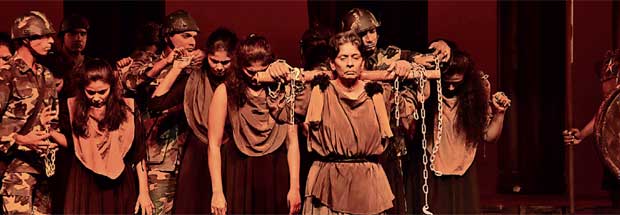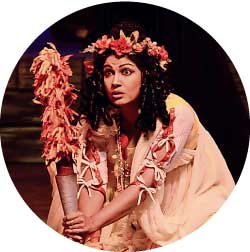Reply To:
Name - Reply Comment
Last Updated : 2024-04-19 00:00:00
 I have not read Sartre’s version of The Trojan Women. I have seen Michael Cacoyannis’ movie adaptation, but that was not Sartre. I have also seen Dharmasiri Bandaranayake’s Trojan Kanthawo, but that wasn’t Sartre either. When the latter was first staged at Colombo more than two decades ago, it was greeted with the kind of acclaim and popularity that no other political play, except Bandaranayake’s previous work, had enjoyed. So much so, in fact, that with a cast numbering more than 40, a ravishing score by Rookantha Goonethilaka, and choreography by Jerome de Silva, it seemed to belong more to the Wendt than to the Lumbini Theatre.
I have not read Sartre’s version of The Trojan Women. I have seen Michael Cacoyannis’ movie adaptation, but that was not Sartre. I have also seen Dharmasiri Bandaranayake’s Trojan Kanthawo, but that wasn’t Sartre either. When the latter was first staged at Colombo more than two decades ago, it was greeted with the kind of acclaim and popularity that no other political play, except Bandaranayake’s previous work, had enjoyed. So much so, in fact, that with a cast numbering more than 40, a ravishing score by Rookantha Goonethilaka, and choreography by Jerome de Silva, it seemed to belong more to the Wendt than to the Lumbini Theatre.
What differentiated Trojan Kanthawo from Eka Adipathi and Makarashaya was that there was nothing satirical about it. Both Eka Adipathi and Makarakshaya were about power and the struggle to retain power through deception. They were also very contemporary, by which I mean they were set in the 20th century, when plays that delved into the abuse of power were laced with humour, with scorn, with derision. The antagonists, who were always the rulers, were subjected to ridicule and parody. They were meant to make you laugh a little, to make you ridicule the system they were in control of. Bandaranayake’s great achievement, going by that, was his ability to bring together humour and anger when critiquing that system.
Perhaps it was this that led Piyaseeli Wijegunasingha to criticise those two and praise Trojan Kanthawo. However, the criterion she used to negatively review The Dragon – that it wasn’t re-contextualised enough – she discarded to praise Bandaranayake’s transposition of Euripides. Her argument was that a play reflecting a certain context needed to be revisited and, if necessary, revised if it were to be made relevant to a contemporary audience. A friend of mine, having seen these plays, remarked to me that they tried to root a foreign experience here without any success. But that’s not the real problem. The real problem has to do with whether they were adapted cohesively.
Piyaseeli might have seen in Makaraskshaya everything that was wrong with the Sinhala political theatre of her time. It thrived on symbols, metaphors, and stark, clearly defined dichotomies which never yielded. For a political play to thrive on such symbols, however, there must be victory and there must be defeat. No one would have been enthralled by those symbols if they didn’t assume their own opposites. The Dragon in Makarakshaya, for instance, is there because of Lancelot. It doesn’t have any meaning outside itself without him. The context as such, in one sense, flows from this dichotomy. Such a dichotomy is missing in Trojan Kanthawo.
Euripides staged The Trojan Women in 415 BC as a response to the Athenian enslavement of the women and children of a small island in the Aegean. It was profoundly radical, so radical, in fact, that when he staged it for his time, he staged it for all time. He said what he wanted to say and said it in the simplest way he could. There were no villains and no innocents to compare them with. It was, and it remains, the most poignant lament for the loss of freedom authored by a Greek playwright.
Moreover, his message was so aligned with his time because of his victims and the horrible destinies they helplessly await: Cassandra expects Agamemnon, who will make her his concubine, Andromache struggles to raise her only son while doubting his fate, Helen contemplates her own follies that led to her city’s destruction, while Hecuba, the mother figure, looks on wearily at the remains of her motherland. The slaughter of women and children across the Aegean by Euripides’ own rulers: this brought out the parallel he might have looked for with the Trojan War.

And in the end, it became both profound and simple. And simplified. In The Dragon, there was room for a conflict that would end in some resolution. But in Trojan Women, the conflict as such could only lead to complete annihilation. So when Dharmasiri Bandaranayake adapted it in the late nineties as a response to the Civil War here, he went for probably the most relevant play he could have gone for, doing away with those dichotomies that had characterised his earlier work. What was so easy about Euripides, however, eventually became what was so difficult about it.
The Trojan Women is so matter-of-fact that adaptation or re-contextualisation is possible only with explicit add-ons. This is not something to be met with in The Dragon, or even Brecht’s The Threepenny Opera, both of which were adapted here and were in turn adaptations of popular folklore. The symbols in them are already there, derived from the myths that inspired them. Euripides’ play, on the other hand, was conceived with a point of reference that was relevant to his time. The only way an adaptation could work, not surprisingly, was by explicit symbols which showed how the playwright had tried to bring its message closer to home.
To a considerable extent at least, this explains why in Trojan Kanthawo, Bandaranayake (together with Rookantha Goonethilaka’s score) brought on stage the modern war tank and the Sinhalese soldier. There was always a sense of political explicitness in his production, as such, that one did not come across in Makarakshaya, by which I am not paying it a compliment: the truth is both Eka Adipathi and Makarakshaya were aware of their relevance, while Trojan Kanthawo could not have projected such a relevance without resorting to symbols.
But this wasn’t all. Inasmuch as these symbols were add-ons, they or rather the political undertones beneath them were undone by something that Bandaranayake should have removed, but did not remove: divine intervention. In bringing on stage the army tank and the Sinhalese soldiers, with those laser sound effects that were unfortunately at odds with the seriousness they tried to evoke (which is why I have reservations about Rookantha’s score), he was secularising a war that was rooted in a struggle between the gods, as seen in the beginning with an argument between Poseidon and Athena. By refusing to do away with those gods, however, he confounded us. Again, I am not paying a compliment: without a proper justification for this incongruity, Trojan Kanthawo eventually becomes a hazy political comment.
 There was nothing divine about the Civil War we endured for three decades. There was nothing that could explain it, rationalise it, except the follies of human beings. That latter point was what Trojan Kanthawo brought out, however roughly and explicitly, with the intrusion of the Sinhalese soldiers. But when I see Poseidon arguing with Athena about how to punish the Greek army, when we know for certain that this same Greek/Sinhala army are enjoying their spoils and captives, I wonder where Bandaranayake was more inconsistent: his choice of allegorising Euripides as a comment on our time, or his choice of retaining the gods as a comment on their time. What was Trojan about our war, and what was Sinhalese and Tamil about their war? The one was divine, the other secular. Can they really subsist?
There was nothing divine about the Civil War we endured for three decades. There was nothing that could explain it, rationalise it, except the follies of human beings. That latter point was what Trojan Kanthawo brought out, however roughly and explicitly, with the intrusion of the Sinhalese soldiers. But when I see Poseidon arguing with Athena about how to punish the Greek army, when we know for certain that this same Greek/Sinhala army are enjoying their spoils and captives, I wonder where Bandaranayake was more inconsistent: his choice of allegorising Euripides as a comment on our time, or his choice of retaining the gods as a comment on their time. What was Trojan about our war, and what was Sinhalese and Tamil about their war? The one was divine, the other secular. Can they really subsist?
Perhaps a comparison with The Dragon might help. The titular dragon in there was a metaphor, and a very malleable one at that. It was possible to reconfigure, to re-contextualise, without losing the mythical overtones of the original. To be sure, it was a myth turned inside-out, but we knew it was a myth all along, even when Lancelot remarked, “We’ll have to kill the dragon in all of them” when he discovered that the Burgomaster had taken over his foe’s position. It was a classic case of the mythical not trumping the secular. There was no question about its relevance, consequently: in the end, it resorted to popular folklore to reflect on the present.
This leads me to my final question: has Trojan Kanthawo, which was staged again two weeks ago at the Wendt, outlasted its relevance in a way that Bandaranayake’s other work has not? I wouldn’t like to say that it has, but then that’s the only answer I can think of. Forget the point that the war is over: war is everywhere, even in times of peace, and it would be futile to think otherwise. Reflect instead on the central conflict I highlighted before. Wasn’t Bandaranayake’s aim to critique what he conceived as a war fought against our own people? If so, why did he secularise it without doing away with those gods? Particularly when wars are fought with or without Olympus? These are questions, yes, but they make me unhappy, not because they can’t be answered, but because we choose not to answer them.

Add comment
Comments will be edited (grammar, spelling and slang) and authorized at the discretion of Daily Mirror online. The website also has the right not to publish selected comments.
Reply To:
Name - Reply Comment
On March 26, a couple arriving from Thailand was arrested with 88 live animal
According to villagers from Naula-Moragolla out of 105 families 80 can afford
Is the situation in Sri Lanka so grim that locals harbour hope that they coul
A recent post on social media revealed that three purple-faced langurs near t